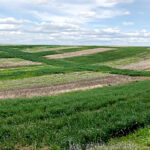
Sally Brown
BioCycle August 2014
Last month, I was able to do one of my favorite things — swim in Lake Michigan, where turning to breathe gave me views of Chicago’s downtown skyscrapers. Lake Michigan was really nice because the beaches in Chicago are a party on the weekends with music, dancing, kids, and people of all colors and sizes. Also the water clarity was so good I was able to dive down and retrieve three $1 bills stuck in the sand along different parts of my route.
The Clean Water Act of 1972 has given us pots of gold, both literally and figuratively. As a result of the Act, waters in urban areas are much cleaner. I swam in Chicago, but could also have registered for open water swims in Seattle, New York and Boston, on that formerly infamous River Charles. However, despite its benefits, the Act is also an example of politically compromised legislation. Don’t try swimming in Lake Erie off the shore in Toledo, for example. Nonpoint source pollution was the missing link in that legislation and is what is responsible for the algae blooms there today.
I was in Chicago for the Soil in the City conference, which featured talks on urban agriculture, urban soil contamination and green infrastructure. The critical importance of environmental regulation was brought home in a talk given by Rajeev Sikka from Punjab Agricultural University in India. He explained how the lack of environmental regulation with the subsequent lack of effective wastewater treatment in his country was poisoning fields and rivers with excess nutrients, much like what went on in the U.S. prior to passage of the Clean Water Act. Environmental regulation can be a tool for change and growth. The Soils in the City conference also made clear how critical appropriate environmental regulation in urban areas is to make our cities as liveable as the Clean Water Act has made our waters swimmable.
The potential for what can be accomplished through greening urban environments was evident in talks throughout the conference. The meeting started with a presentation by Frances Whitehead, a professor from the Chicago Art Institute, describing her design for a greenway leading to the lake. A lunchtime talk was given by Erika Allen, head of the Chicago chapter of Growing Power, the grassroots urban agriculture movement started by her father Will Allen that has been transforming landscapes and lives. There was also a talk and a tour about an area of Chicago where green storm water infrastructure has transformed an area of urban blight while simultaneously reducing storm water runoff and associated treatment costs.
Complementary, Not Contradictory, Rules
The presentations at Soil in the City highlighted the need right now for environmental regulations that can help to accelerate the greening of urban areas. Types of regulations that would accomplish this include those that encourage waste diversion to composting sites and allow for use of residuals-derived products in urban greenscapes. Regulations that encourage and support urban agriculture, including use of residuals-based amendments to grow food. Regulations that allow for green storm water infrastructure in lieu of or in combination with grey infrastructure.
But if you look at Chicago, the city with the wonderful swimmable lake (that is also fishable and is the source of the city’s drinking water), what you find instead of consistent regulations is a confusing and contradictory set of rules. Urban agriculture is great, but urban soils may be contaminated. And guidance on what is considered contaminated isn’t clear.
A standard urban agriculture policy in Chicago had been excavation with removal and replacement of soil down to five feet. I was told that this rule is being softened to allow for impermeable layers between raised beds and the contaminated soils. But this requires new soil to put on top of the clay. As the Illinois EPA currently does not allow the Class A biosolids produced by the Metropolitan Water Reclamation District of Greater Chicago (MWRD) to be used to grow food, and as food scraps are primarily landfilled in the state, coming across replacement topsoil is not so easy.
Making sound environmental regulations is exceedingly difficult and involves navigating a series of often contradictory interests, ideas and goals. The Clean Water Act for example, however effective it was in urban areas, accomplished very little in terms of controlling nonpoint source pollution (discharges not coming from discernible, confined and discrete conveyance such as pipes). Too much political pressure to touch that one and as a result, we are now seeing dead zones in the Gulf of Mexico — the result of nonpoint source runoff of farm nutrients.
Bogging Down The Process
What is happening in Chicago regarding urban soils and urban residuals is characteristic of what is going on in many cities. The movement to turn landscapes green via farms and greenscapes is coming head to head with the regulations trying to protect citizens from their wastes and their soils. By emphasizing the potential threats associated with those wastes and soils, the regulators are effectively slowing the greening movement — and thus the benefits associated with green urban areas are slowed, minimized or lost. Take urban agriculture as an example. What the regulators restricting access to soils are concerned about is elevated blood lead as a result of contact with soil. In reality, elevated blood lead in kids in urban areas can result from a number of factors including exposure to lead paint and lead contaminated dust. Lead in soils is a concern because kids will inadvertently or on purpose lick their dirty fingers and ingest soil. Bare contaminated soil can also turn to dust and get into houses. The threat is worse for kids who are hungry or malnourished.
The fear of lead contamination that has regulators developing rules requiring soil excavation to protect public health also hurts those very same children that they are trying to protect. Community gardens protect public health on many levels, including protection from elevated soil lead. Public health protection comes from benefits associated with an active community garden: Improved food access and security, increased physical activity and reduced crime to name a few. At the same time, the soils in those gardens can be amended with composts and biosolids, reducing both the total lead concentration and the potential for exposure — hence the hazard. Soils that support healthy vegetation are less likely to turn to dust. The kids who eat the healthy vegetation are less likely to be malnourished and so less likely to absorb the lead. Those same kids that regulators are worried about re: soil lead are even more likely to be facing the impacts associated with poor nutrition, low physical activity, and high crime neighborhoods. Restricting urban agriculture, even with the best intentions, is potentially hurting more than helping.
This rings particularly true when one considers the potential sources for clean soil that are going untapped, also in the interest of protecting public health. The municipal biosolids produced in Chicago are as clean as the ones that grace the Tacoma, Washington community gardens. Illinois EPA is basing the decision to prohibit biosolids use on history, not on the product or the science. Food scraps diversion is another example. Here regulators are likely concerned about vector attraction if food waste is collected separately from solid waste. The experiences of a growing list of municipalities show the flaws in that logic.
Developing good regulations to protect public health in the environmental arena is not easy. It has traditionally involved multiple agencies working on multiple levels. What is needed are rules that are consistent across these agencies and levels that take into account the range of factors involved and come up with a compromise solution that will be protective in the broadest sense possible. I didn’t say that it would be easy — but imagine the benefits. Almost as good as a swim in Lake Michigan and certainly more profitable.
Sally Brown is a Research Associate Professor at the University of Washington in Seattle and a member of BioCycle’s Editorial Board.










